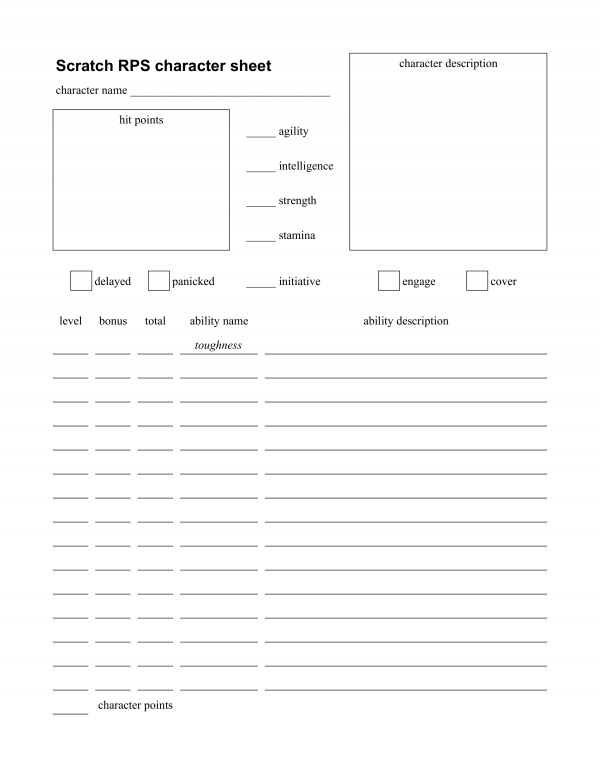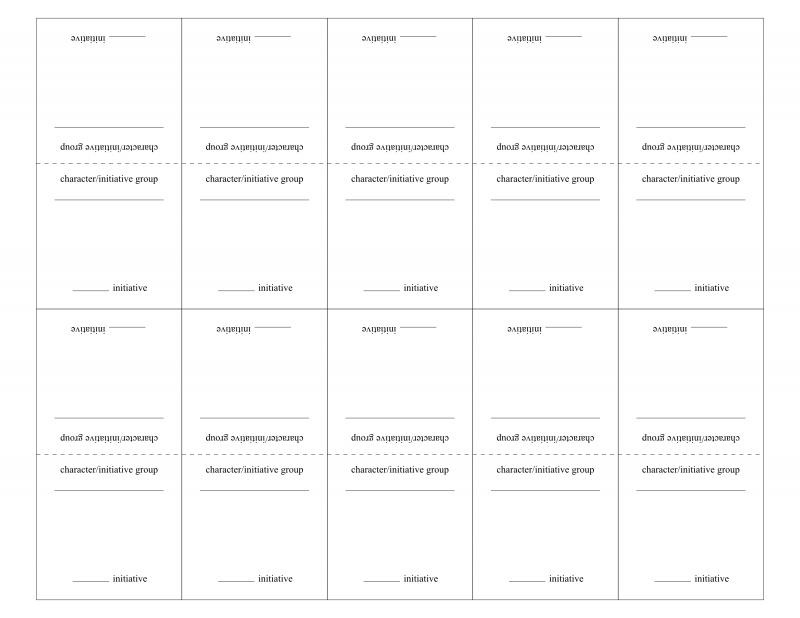Talk:Scratch
Contents
simplified healing
What if we simplified the healing rule so that characters can only be healed once per encounter, but healing always restored the character to healthy (stamina +1)? (I realize that there currently is no limit on healing, but a more complex healing limit than what I have proposed here is may soon be incoming.)--BFGalbraith 18:04, 31 May 2011 (UTC)
altered states
Players have suggested using a coin to keep track of whether you are delayed.
We could put checkboxes on the character sheet to remind players of states they may need to keep track of whether they are delayed or panicked, whether they have -2 defense from the engage action or +2 defense from the take cover action, and perhaps their initiative.
- The other option would be two boxes each labeled (outside of the checkbox) "yes" and "no." However, this character sheet below with just the one checkbox each is great, best character sheet we have so far, and doesn't seem to need separate checkboxes for yes and no.--BFGalbraith 21:56, 3 June 2011 (UTC)
Initiative cards are another useful tool for keeping track of the order of characters turns (3x5 cards folded in half, with character names and initiative arranged in order of initiative.) State flags can be attached to initiative cards (i.e. stick a small post-it or sticky colored dot on the card to indicated delayed.)
In The Dark Woods and some other games, all characters controlled by the same player should have the same initiative. But in GM-ed games like Squawk, the GM will sometimes control groups of enemies that should have different initiative.
initiative groups
We should implement this by saying that each player has an initiative group and the characters the player controls are in his initiative group. This makes it easy for us to add multiple initiative groups for GMs in optional rules. For example:
- Each person controlling characters has an initiative group. The initiative group contains the characters that person controls.
- Initiative groups take turns during encounters. At the beginning of each encounter, roll a twenty-sided die for each initiative group to determine the order of their turns. This is the group's initiative roll. Groups take turns in order from the highest initiative to the lowest. If two groups have the same initiative, break the tie by rolling another die for both groups until one of them rolls higher. That group goes before the other.
- Each character has a turn during each turn of their initiative group. The player controlling the group chooses the order of the turns of the characters in the group.
The above is good group terminology & rules. --BFGalbraith 16:59, 2 June 2011 (UTC)
initiative bonuses
How should individual stealth and detection levels affect an initiative group's initiative roll? Consider three situations (A) a PC with 2 minions, (B) a group of identical NPCs and (C) a group with two kinds of NPCs. Situation C can happen in TDW when a team of 3 fights a boss controlled by a team of 2. Situation C will not happen in Squawk if we give each type of enemy it's own initiative group.
PROPOSAL I: add all of the initiative bonuses together
- This is the easiest one to implement, because the description of each ability currently says it adds a bonus to the character's initiative roll. We would simply change this to say it adds a bonus to their initiative group's initiative roll.
- Unfortunately this seems counter-intuitively biased to give large groups of characters a high initiative bonus. It is especially bad in situations B and C (identical NPCs or different NPCs.)
PROPOSAL II: lowest stealth bonus + highest detection bonus
- This makes the most sense because group initiative is based either on your weakest link (because his clumsiness gives away group location,) or it is based on your most proficient member (because he's your most effective scout.) It is particularly simple and intuitive in situation B (identical NPCs), which is common in both TDW and Squawk.
- This is a little bit more work than proposal I, because we have to say that each bonus only applies if it is the lowest or highest bonus from other characters with the same ability. However this is actually less math because you only have to multiply out the stealth and detection bonuses for characters with the lowest stealth and highest detection.
- "Lowest stealth" doesn't make any sense to me narratively, unless you mean "0" when you mean "lowest," but remember 0 = no ability, so no one actually has level 0 of any ability, because level 0 does not exist.
PROPOSAL III: highest stealth bonus + highest detection bonus
- Same work as proposal II without the "no 0" problem of "lowest stealth." Narratively it is less intuitive to use the best stealth bonus of a group, but your stealthiest scouts might move ahead of your noisier characters to flush out enemies before they hear the noisy ones.
- This one is currently my favorite. --SerpLord 23:17, 3 June 2011 (UTC)
PROPOSAL IV: each character rolls for initiative, and the group's initiative is the highest roll of any character in the group.
- lots of rolling and adding. Statistical stuff happens when you choose the best of several die rolls. See Proposal III, which would have a similar result with less rolling and adding.
holding the person who is holding you
If you have wrestling ability and you are both healthy and delayed, you can use wrestling to hold one character who successfully held you since your last turn. This hold does no damage.
taking cover while reloading
The bonus and penalty from take cover should last as long as you want, but while you are in cover, you cannot do a close range attack, evade, intimidate or surprise.
You can use healing ability, do long range attacks (with the -2 penalty) or choose to do nothing while you take cover.
- There is no penalty for using healing ability when you take cover, so it is always better to take cover when you use healing. Does it even make sense to take cover when you are healing an ally?
What if you are held while you are in cover?
What if you are panicked while you are in cover?
grid movement when you are delayed by your own moves
- Being delayed by your own knockout, shooting or blasting shouldn't keep you from moving.
- Getting delayed by a hold action should keep you from moving.
- Should being delayed by a distract action keep you from moving?
- Should we distinguish delayed vs. delayed + immobilized with technical terms?
balance between abilities
Most of our ability levels are well-balanced. Increasing stalking ability, movement ability, craftsmanship or healing from level 1 to level 2 is worth about the same increasing an attack ability from level 1 to level 2. (Swimming levels might be a little underpowered.)
command levels are too valuable
Command ability is worth about 3 times as much as other abilities against enemies with 11 defense, about twice as much as other abilities against enemies with 16 defense, and about the same as other abilities against enemies with 20 defense.
- We could reign in command by thinking beyond the individual encounter. Perhaps healing and replacing command ability minions is more difficult than healing and replacing PCs between encounters. --SerpLord 22:55, 2 June 2011 (UTC)
- What if minions CAN be healed, but only between battles, and only with successful healing rolls? --BFGalbraith 22:16, 3 June 2011 (UTC)
- That would make command ability depend on healing ability, and it's not consistent with the idea that you might recruit minions or create them with something other than healing ability. --SerpLord 04:37, 4 June 2011 (UTC)
toughness is too valuable at medium levels
Characters with 1 level of attack ability have a strong incentive to increase their toughness up to level 7, 8 or 9 before they develop any other abilities. This means that instead of a more or less even distribution of a characters with 5 to 10 toughness at the end of the game, optimizing players will ALL have 9 toughness at the end of the game, and very low levels of other abilities that don't pay off as much per level.
- We could reign in toughness by thinking beyond the individual encounter. For example suppose sorcerers in TDW automatically heal up to stamina + 1 between encounters. Then they can make a detection, craftsmanship or healing roll to regenerate themselves to full HP. (Note: toughness was not in that list.) If we want to be even more brutal, we can have the difficulty depend on your toughness, stamina or the amount of damage you have taken. --SerpLord 22:55, 2 June 2011 (UTC)
level 1 abilities have very different values
Having at least 1 level of certain abilities adds extra value.
- (~5 levels) your first attack ability doubles attack power when healthy
- (~5 levels) healing potentially heals several points of damage
- (~5 levels) non-flying characters can't hit flying characters with close range attacks when they evade or use a long range attack
- (~1 level) craftsmanship versatility
- (~1 level) your first stalking ability (surprise action)
- (~½ level) command ability intimidate action
- (~½ level) non-swimmers and long-range attacks can't hit character who use swimming to evade
- (0 levels) other movement aiblities
more realistic healing options
games without healing ability (dinosaurs and prehistoric animals)
hardcore
- HP never goes up during combat
- damage always represents injuries that take a long time to heal.
- It never represents physical or psychic pain, suffocation or stunning effects that people can recover from during combat. (This could make the rule incompatible with some settings or other optional rules like skills.)
- healing still used in combat with death rules?
- does first aid remove the healer from combat?
- NO, either you can use healing as a combat action or you don't use healing until hostilities stop. This is all about how you interpret the duration of combat.
- If you insist on a very quick flow of combat without pauses for maneuvering and orientation (combat takes seconds), then there is not time in a battle to treat multiple injured allies, and it is not necessary or even appropriate to treat injured allies during combat.
- If combat turns are more like camera shots in an action movie and clashes in a real fight, which are interrupted by pauses and maneuvers that vary in duration (combat takes minutes), there is time in a battle to treat multiple injured allies or treat an ally and then return fire at an enemy.
- NO, either you can use healing as a combat action or you don't use healing until hostilities stop. This is all about how you interpret the duration of combat.
- does first aid remove the healer from combat?
milder
- you can only be healed from being incapacitated once per battle. We could give this state a name, like convalescent or wounded.
- we could also limit each healer to healing one character form injured to healthy once per battle.
healing between battles
- everybody heals to stamina + 1 between battles (balance and stability - game designers know you will have most of your HP when you enter a battle.)
- make toughness roll to heal yourself to full HP
- make healing roll for each ally to heal them to full HP
healing skills
- special healing skills might be able to heal you when normal healing actions cannot.
- special toughness skills might allow you to be healed more often.
- toughness skills that help you be healed?
optional death rules
realistic or brutal games like Resilience might have death rules that add dramatic tension and character expendability.

